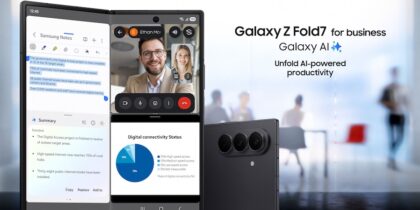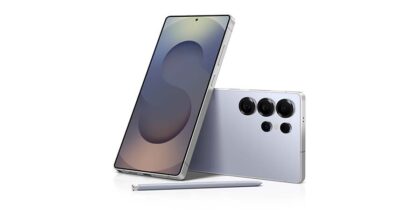For most chief information officers (CIOs) and forward-thinking business owners, the question of whether mobile technology needs to be part of their business strategy was answered long ago with a resounding “yes.” Most personal computing now happens on mobile devices. Most business emails are read from mobile devices. And with application virtualization and docking technologies like Samsung DeX, there’s nothing you can’t do with the right mobile device — and many things you can’t do without one.
Mobile technology return-on-investment (ROI) discussions are now largely about determining where to focus new investments and how to deliver on the promise of mobile transformation without exposing an organization to new risks or hidden costs. Often, the question isn’t if you should add mobile technology but when and where it fits best.
Organizations of all sizes should better their understanding of the economics of mobility. Business leaders and CIOs in particular should also learn the associated costs and possible risks.

In prioritizing and organizing your mobile investments, deconstruct the tasks and processes users engage in and make some testable assumptions about what new habits and activities will look like.
Here are some ways to help you consider how added mobility may affect — and improve — your workflow.
Quality/Reduction in Errors
Most organizations see an increase in information quality and a decrease in errors and resultant rework. Capture this benefit by identifying your current process for fixing mistakes, which may be inefficient or ad hoc. In dealing with incorrect product shipments, for instance, you might do any/all of the following:
- Process the request or ticket the mistake
- Pay return shipping
- Offer the customer an apology discount
- Process a replacement order
- Receive a returned product and determine whether it can be resold
Plan to cut your errors in half. Actual results may be even better.
Days Sales Outstanding (DSO)
To impress your chief financial officer (CFO) or accountant, include in your calculations the impact on DSO. It’s a way of thinking about how long you have to wait for your money and how much cash you have for day-to-day operations. DSO is the number of days of sales you have in receivables, waiting to be paid. For instance, if you sell an average of $1,000 of product every day and your customers collectively owe you $10,000, your DSO is 10 days. This can represent how large a credit line your company needs to operate.
Maximize Your Mobile Value
Get Oxford Economics' definitive report on the costs and benefits of employee mobile devices. Download Now
Mobility projects can impact DSO in various ways, such as:
- Capturing that a product/service has been delivered and immediately beginning the invoice process (instead of waiting for paperwork)
- Accepting credit card or Automated Clearing House (ACH) payments triggered by product delivery or shipping
- Accurately capturing volume or quantity from accessory or sensors, eliminating errors and associated delays
Device Consolidation
Replacing traditional computers with mobile devices better suited to individual work styles benefits companies and users alike. Common device consolidations include:
- Replacing a rugged barcode scanner and desktop computer with a smartphone in a barcode scanner case
- Replacing retail cash registers, barcode scanners and time clocks with a set of tablets
- Replacing laptops, tablets and smartphones with a single Samsung smartphone and DeX setup
IT Management Costs
Eliminating nonmobile devices in particular will substantially reduce the time required to manage and support your computing endpoints. In general, desktops require significantly more IT support than mobile devices over the course of a year.
With smartphones and tablets, configuration changes, updates and some service issues can be dealt with remotely, even automatically, so an IT manager needn’t see the device in person. Plan to reduce IT support activities by 75 percent, but your results will likely be even better.
Spending
Capturing a project’s hard costs is the easy part. Many proposals fail because accounting minds are more comfortable with hard costs than with benefits. These costs are easier to manage when you design a project around company-owned devices rather than individually owned devices or Bring Your Own Device (BYOD). BYOD used to be thought of as a way to reduce costs, but in reality is less so, especially as mobile device deployments have become more common and easier to manage. Standardization and corporate buying are far more efficient than relying on employees’ technology choices.
Devices
When choosing devices, it’s critical to look carefully at each user group and their mobility needs. Mobile devices are available in a wide range of form factors, price points and feature sets. Samsung’s Galaxy S10 and Note10 devices, for instance, offer PC-like processing power, advanced camera systems and the latest biometric features, but Samsung also offers the Galaxy A series for business productivity at much lower prices. If your workforce is operating outdoors or in an industrial environment, ruggedization should be a key decision making criteria.
Consistency in kitting, support and management practices will keep costs down. Make sure to plan for both the initial deployment and how you’ll maintain the program as devices are broken or lost.
Accessories
Most mobile devices require some accessories, cases being the most common. Even knowledge workers benefit from the right accessories. High-quality accessories can promote adoption by giving users confidence that the device will be protected in the environments where they use it and that it will work reliably. Buying in bulk is the easiest way to minimize costs, so plan to make an initial purchase including some ready-to-go replacements.
Common accessories include:
- Rugged cases
- Screen protectors
- Wireless headphones
- Spare chargers
- Samsung DeX adapter for converting to desktop mode
- Bluetooth keyboard and mouse
- S Pen for customer signatures and more
Specific industry use cases may call for one or more of the the following:
- Barcode scanners
- Card readers
- Wall-mounting hardware for tablet-based kiosks
- Belt clip or arm mount
- Bluetooth-paired sensors
- Car-mounting hardware
Security and Management Software
Mobile OSs are designed to be secure and easy to manage, especially in the context of how and where users are doing their computing today. You will have some expense here and it will likely involve more than one layer, especially if you have a diverse set of use cases. Regardless of what you’re doing in your IT environment, you should be investing in improved mobile security. Security threats are evolving, and no business is being spared. This expense is likely to include some or all of these categories:
- Mobile device management (MDM), enterprise mobility management (EMM) or unified endpoint management (UEM): Every mobile OS has a set of controls — an application programming interface (API) — that can be accessed through MDM/EMM/UEM software to monitor, secure and even control devices remotely. Most modern solutions in this category are cloud-based and available for reasonable subscription fees. Samsung devices have an advanced set of controls accessible through an MDM/EMM/UEM thanks to the Knox platform. Samsung also offers Knox Manage — a full-featured, affordable MDM.
- Malware protection: While EMM allows controls and security policies to be enforced on all devices, the security issues caused by malware — including zero-day upgrades pushed by the EMM — require a modern antivirus solution. An AI-based solution such as Cylance scans all files and apps to make sure they’re quarantined before they execute on the device.
Support
Whatever the scope of your mobility project, some devices will break, some will get lost, and some will withstand occasional ill intent. Deployments of hundreds of devices routinely experience service request rates of 3 to 12 percent, depending on their context and complexity of environment. It may be difficult to extrapolate how much support you’ll need in production mode until you have a lot of devices in the field and can more easily outsource to a third party. They’ll have a more complete understanding of what’s likely to go wrong and will establish standard operating procedures (SOPs) with you during onboarding. These services, often referred to as managed mobility services (MMS), can take a lot of the guesswork out of developing your program processes.
Insurance/Replacements
Mobile devices’ portability means you can use them in more places — some of which put them in harm’s way. Every month, a portion of your support requests will be for replacement devices. Insurance and warranty management can be built into the logistics plan to help minimize costs. And having replacements on hand ensures users always have access to a device.
Logistics
While many management tasks can be completed remotely, devices will typically need some accessories, added through kitting. Mobile deployments commonly include cases, sleds, special sensors or mountings. Some kitting can be pushed to users, but having a central resource complete the kitting means users aren’t forced to learn the process before they can use their devices, which can deter or eliminate adoption.
Once a device and accessories are kitted, they will need to be packed and shipped. The larger the deployment, the more likely that shipping accuracy will factor into returns and lost devices.
Devices in the field will need to be retrieved and replaced. Develop a process so that it isn’t an emergency when it happens — which it will. This cost can also be outsourced. If you have more than 100 devices in your deployment, an MMS provider can likely do this work more reliably and inexpensively. The avoided mistakes will be more than worth the cost.
Connectivity
Unless devices are used exclusively on Wi-Fi, cellular connectivity will likely make up the largest single cost in your mobility program. Connections on 4G and 5G networks provide extraordinary speed and reliability but also come with monthly service plans.
That said, the mobile plans offered for business accounts are significantly lower than what the average consumer pays. This means that in many cases, it may economically make more sense to provide corporate-owned devices to employees, rather than paying employees a stipend for their personally owned devices under a BYOD policy. For sufficiently large deployments, a third party — such as an MMS or telecom expense management (TEM) provider — will manage your contract with the carrier and make sure you’re only buying the services you need.
Managed Services, Devices as a Service (DaaS)
All of the services related to managing a mobile environment are available from managed services providers. Some can offer all these services and include them with device leasing — and all the necessary software — for a single monthly fee. Any deployment of 100–5,000 devices is a good candidate for these services. These providers have the processes and capabilities you need, so you can focus your time and attention on optimizing the program to achieve your business goals, instead of trying to get all the moving parts right.
Risk Factors
When completing an ROI, gather all risk-related factors separately from those more easily measured. You’ll have both increases in risk and decreases in risk, which you may be able to balance. Risk factors are highly variable — and easy to sell to your CFO as justification for or against doing something — but they can be valuable in determining how you approach your project to minimize their impact.
Adoption
Lack of adoption is the leading impediment to ROI in mobile and digital transformation initiatives. Factors that support adoption include:
- Excellent logistics and support, removing user startup burdens: User confidence, once lost, is difficult to win back.
- Devices that are trustworthy and easy to use: No matter how rickety or inefficient the old method was, the “known evil” will triumph over anything new unless users believe their efforts to change will have meaningful results.
- A focus on user experience (UX) in selecting apps and services: Almost everyone working for you will already have had many great user experiences using smartphones, tablets and web apps. Regardless of how much effort you put into your project, it will be compared against the very best of optimized consumer experiences by your users. The best way to deal with this is to plan on monitoring usage and user experience and making changes often to improve the experience, at least in the initial phases of your deployment.
Security
Mobile device deployments make work and transactions available more broadly, but this also extends the edges of your security environment. Mobile OSs and security software are architected to be more secure and easier to maintain than computer OSs of the past. But still, you’re giving sensitive data or internal system access to devices that people want to be able to easily access dozens or hundreds of times a day. Security risk can be minimized by many means, including:
- A high-security hardware platform such as Samsung Knox, with multilayered protections
- An EMM solution that allows fine controls around access and management
- Antivirus software on all devices to protect them from malware, even while connected to a network
- Data and system categorization by levels of sensitivity, plus layered access-granting
Market Access
If you operate in a competitive market, the risk of market share being stolen by more a customer-friendly business or improved customer experience is very real, and mobility has played a significant role. The rise of online retail and ride-sharing services represent dynamic shifts in market share based on customer-first mobile technology. Those same principles apply to smaller customer decisions and markets.
Getting to ROI
ROI calculations are useful whether 100 percent accurate or not. It’s worthwhile to develop a process for prioritizing projects based on a set of testable assumptions and solid, experience-based data. You’ll likely need to invest in mobility — and other parts of digital transformation — for the foreseeable future. Constantly improving your ROI process will help you make ever-better decisions. Doing nothing isn’t worth the risk.
Explore how mobile workspace solutions can improve your teams’ productivity and collaboration, while reducing your overhead costs, and sign up to download your free, complete guide to rolling out a mobile-only solution for your workers using Samsung DeX.









